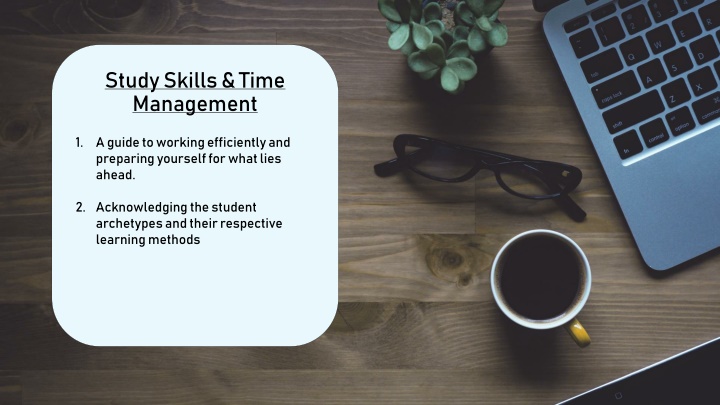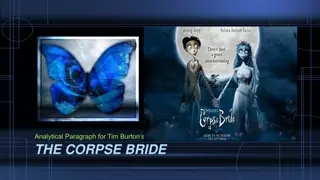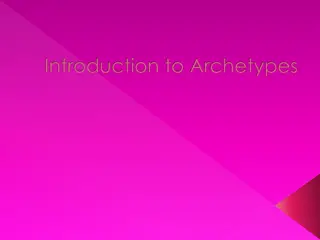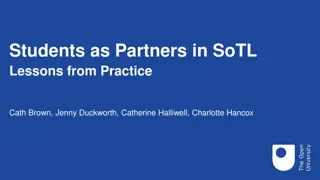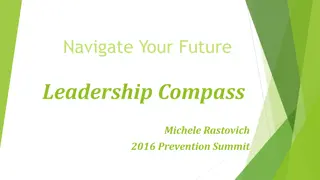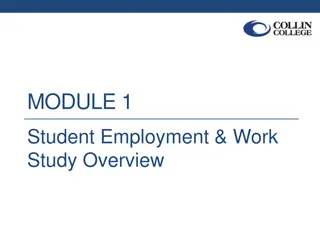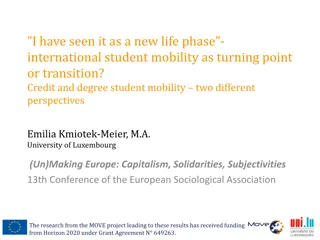Student Archetypes and Effective Study Strategies
A comprehensive guide on understanding student archetypes - The Dreamer, The Worrier, The Perfectionist, The Crisis Maker, and The Over-Doer. Learn practical study strategies tailored to each archetype to enhance efficiency and academic performance. Discover tips for time management, overcoming distractions, dealing with anxiety, and improving productivity.
Download Presentation

Please find below an Image/Link to download the presentation.
The content on the website is provided AS IS for your information and personal use only. It may not be sold, licensed, or shared on other websites without obtaining consent from the author.If you encounter any issues during the download, it is possible that the publisher has removed the file from their server.
You are allowed to download the files provided on this website for personal or commercial use, subject to the condition that they are used lawfully. All files are the property of their respective owners.
The content on the website is provided AS IS for your information and personal use only. It may not be sold, licensed, or shared on other websites without obtaining consent from the author.
E N D
Presentation Transcript
Study Skills & Time Management 1. A guide to working efficiently and preparing yourself for what lies ahead. 2. Acknowledging the student archetypes and their respective learning methods
The Archetypes 1. The Dreamer 2. The Worrier 3. The Perfectionist 4. The Crisis Maker 5. The Over-Doer
The Dreamer Easily distracted Has trouble planning the details of a project Has difficulty following through on projects
The Worrier Not a huge fan of change Likes to stay in the comfort zone Puts off tasks in order to avoid anxiety
The Perfectionist Struggles to actually complete the task because they re too busy perfecting it Will put off the task until they feel they can do it perfectly
The Crisis Maker Works better under pressure Gets a rush from waiting until the last minute More creative when working against a deadline
The Over-Doer Takes on too many projects at once Has difficulty prioritizing and staying organized with multiple projects to complete.
For Dreamers Keep a to-do list and complete several tasks a day. Foster creativity by scheduling time to let your mind wander. Break down large projects into a series of achievable milestones. Self-discipline is a better predictor of academic performance than intelligence Students assigned to mental contrasting activity (a visualization method) scored 20%- 35% higher on quizzes than those who visualized obstacles standing in the way of earning a high score.
For Worriers Focus on the task at hand rather than intrusive thoughts. Push through anxiety by working on a little bit each day. Ask for help creating a realistic timeline. Dopamine has a direct correlation to motivation, and its job is to encourage us to act. Lower levels of dopamine cause people to look for the easy way out while high levels of dopamine motivate people to work for intrinsic and extrinsic rewards. Test anxiety and preoccupation with performance have been identified as the greatest sources for negative performance. Learning proper study skills and test-taking strategies have shown to reduce anxiety.
For Perfectionists Ask for help defining realistic expectations. Reward yourself for reaching mini-goals along the way. Seek emotional support when you put too much pressure on yourself. In a 2009 study, Vanderbilt scientists mapped brains of achievers and procrastinators. Those willing to work diligently for rewards had higher levels of dopamine in the striatum and prefrontal cortex areas known to impact motivation. College students who wrote down goals accomplished significantly more than those who did not in a 2015 study.
For Crisis Makers Set your own deadlines in order to create a natural adrenaline rush and complete tasks before they are really due. Rather than relying on stress, figure out other potential motivators that work for you. Engage in leisure activities that give you an adrenaline rush. In a 2006 study, girls had higher levels of self- discipline than boys and displayed 5%-20% more self-control. Girls also earned higher grades than the boys. A 1997 study at Case Western Reserve University found that students who procrastinated had lower levels of stress initially than other students. However, the negative effects of procrastination outweighed the initial benefits as the students who put off assignments earned lower grades and reported higher cumulative amounts of illness and stress. https://www.affordablecollegesonline.org/college-resource-center/study-skills/
For Over-Doers Add downtime to your to-do list. Practice saying no when it s appropriate to do so. Prioritize your to-do list on a regular basis. In a 1995 study, researchers found self- discipline to be the only one of 32 measured personality variables to predict college GPA more accurately than SAT scores. A 2004 study of undergraduates found students with the highest levels of self- discipline self-reported higher grades and a broader variety of personal and interpersonal strengths. https://www.affordablecollegesonline.org/college-resource-center/study-skills/
4 Types of Learning 1. Visual 2. Auditory 3. Kinesthetic 4. Reading/Writing
Visual Someone with a preference for visual learning is partial to seeing and observing things, including pictures, diagrams, written directions and more. This is also referred to as the spatial learning style. Students who learn through sight understand information better when it s presented in a visual way.
Auditory Auditory learners tend to learn better when the subject matter is reinforced by sound. These students would much rather listen to a lecture than read written notes, and they often use their own voices to reinforce new concepts and ideas. These types of learners prefer reading out loud to themselves. They aren t afraid to speak up in class and are great at verbally explaining things. Additionally, they may be slower at reading and may often repeat things a teacher tells them.
Kinesthetic Kinesthetic learners, sometimes called tactile learners, learn through experiencing or doing things. They like to get involved by acting out events or using their hands to touch and handle in order to understand concepts. These types of learners might struggle to sit still and often excel at sports or like to dance. They may need to take more frequent breaks when studying. https://www.rasmussen.edu/degrees/education/blog/types-of-learning-styles/
Reading & Writing According to the VARK Modalities theory developed by Fleming and Mills in 1992, reading/writing learners prefer to learn through written words. While there is some overlap with visual learning, these types of learners are drawn to expression through writing, reading articles or books, writing in diaries, looking up words in the dictionary and searching the internet for just about everything. https://www.rasmussen.edu/degrees/education/blog/types-of-learning-styles/
Tips, Tricks, and Methods 1. Academic Support Center Utilizing the Academic Center is a great practice for 3 of the 4 preferred learning types. At the ASC, students can watch watch as a student works out a problem with them, listen tutor s input and feedback, and lastly, they should leave most sessions with plenty of time reading or writing reading or writing. listen to their The ASC can also act as a student s last line of defense before turning in an assignment or taking a test. https://www.rasmussen.edu/degrees/education/blog/types-of-learning-styles/
Tips, Tricks, and Methods 2. SI Sessions Supplemental Instruction sessions are essentially study groups, except the person leading the session has already passed the class, and excelled while doing so. Attending an SI session may help a student pick up on information they might have missed in class, and reinforce the materials they already knew. It may also benefit the student to hear input from their classmates, giving the session a more interactive feel. https://www.rasmussen.edu/degrees/education/blog/types-of-learning-styles/
Tips, Tricks, and Methods 3. Office Hours Attending office hours can often make the difference between scoring an A or a B on your final project or exam. This gives the student a chance for one-on- one time with their professor, where they can ask any questions they might have or take the time to go deeper into a problem or concept that they didn t fully grasp during the lecture. Some professors make attending office hours mandatory, while others leave it optional. Either way, it is in the student s best interest to attend! https://www.rasmussen.edu/degrees/education/blog/types-of-learning-styles/
Tips, Tricks, and Methods 4. YouTube Outstanding source for visual learners. Sometimes a student may just need to learn the material from a new source in order for it to stick . Pay close attention to your sources! Pay close attention to your sources! https://www.rasmussen.edu/degrees/education/blog/types-of-learning-styles/
Tips, Tricks, and Methods 5. Recording Lectures Outstanding source for auditory learners. Recording a lecture makes it nearly impossible to miss out on the material that a professor provides. It is also a reliable resource on days when the student finds it difficult to remain focused. https://www.rasmussen.edu/degrees/education/blog/types-of-learning-styles/
Tips, Tricks, and Methods 6. Podcasts Another great source for auditory learners. Not only can finding the right podcast provide additional information than what was given in class, but it will also reinforce the materials already learned. https://www.rasmussen.edu/degrees/education/blog/types-of-learning-styles/
Tips, Tricks, and Methods 7. Audiobooks Useful for auditory learners, but much less so for visual learners. Audiobooks can be a lifesaver for working students who can t always find the time to finished the assigned reading. https://www.rasmussen.edu/degrees/education/blog/types-of-learning-styles/
Tips, Tricks, and Methods 8. Annotations Especially useful for reading/writing types, but should likely be made by all learning types (unless you re renting your textbook.) Makes going back through textbooks and handouts a much more quick and efficient process. https://www.rasmussen.edu/degrees/education/blog/types-of-learning-styles/
Tips, Tricks, and Methods 9. PowerPoint (or other digital apps) Creating PowerPoints is a tremendous note-taking method for visual learners, especially in classes where memorizing the materials is necessary. Inserting the materials into a PowerPoint may require more effort, but including charts, graphs, pictures and videos may be an incredibly useful study guide the night before a quiz or test. Index cards work well too, if you don t have a laptop or are technologically challenged. https://www.rasmussen.edu/degrees/education/blog/types-of-learning-styles/
Tips, Tricks, and Methods 10. Taking pictures of the whiteboard May be useful for visual learners. Not so much for readers and writers. Very handy when the student cannot keep up with the professor. https://www.rasmussen.edu/degrees/education/blog/types-of-learning-styles/
Time-Specific Tips 1. Take a photo of your syllabus And email/text it to yourself, just in case. And email/text it to yourself, just in case. Further, it may help you immensely to take the time to add each due date, quiz, and test into your phone s calendar, so you are always prepared for what lies ahead. Having the due dates for each of your classes in a planner or calendar will make you feel more organized and less stressed about the chaotic nature of college life. https://www.rasmussen.edu/degrees/education/blog/types-of-learning-styles/
Time-Specific Tips 2. Set reminders in your phone Its easy to allow a due date to slip through the cracks, especially if you ve taken on a heavy workload. https://www.rasmussen.edu/degrees/education/blog/types-of-learning-styles/
Time-Specific Tips 3. REQUEST TIME OFF WORK REQUEST TIME OFF WORK If you can afford to do so. Taking an entire day or two off work, just before an essay or finals, can be the difference between earning an A or a C. Studies show that cramming is not an effective method for most students. Allowing yourself the extra time to reinforce the material, or take your essay to the ASC, will almost certainly earn you a higher grade. https://www.rasmussen.edu/degrees/education/blog/types-of-learning-styles/
Time-Specific Tips 4. Respect your body s need for sleep Do not buy into the idea of burnout culture. Do not buy into the idea of burnout culture. Misery is not a prerequisite to success. Take care of your body, and the mind will follow suit. https://www.rasmussen.edu/degrees/education/blog/types-of-learning-styles/
Time-Specific Tips 5. The Pomodoro Technique https://www.rasmussen.edu/degrees/education/blog/types-of-learning-styles/
